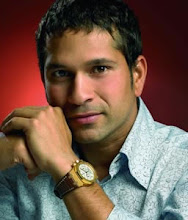He's 35-years-old and owns practically every batting record in the game, but you couldn't escape the feeling that this was probably Sachin Tendulkar's finest hour
December 15, 2008

| ||
As Graeme Swann prepared to bowl the second ball of his 29th over, more than 20,000 people in the stands abandoned their plastic chairs. They were on their feet, creating the sort of bedlam and noise I last witnessed at this very venue seven years ago, when Harbhajan Singh's squirt past point clinched the most famous of India's series victories. Swann bowled. The batsman came forward and patted the ball back with almost exaggerated flourish. The crowd was momentarily quieted but the primal scream started again as Swann went back to his mark.
Again, there was sharp turn, but the paddle-sweep that greeted the ball was emphatic. As it streaked to fine leg, the batsman ran down the pitch and punched the air in celebration, before being held aloft by his equally delighted partner. He's 35-years-old and owns practically every batting record in the game, but you couldn't escape the feeling that this was probably Sachin Tendulkar's finest hour.
To score the winning runs in a record-shattering chase was special enough, but when that last stroke also brought up your 41st century, it became ineffably so. Boyhood dreams are made of this, and it says a lot about Tendulkar that he has never lost that child-like passion for the game.
Even in a world where cricket was played in isolation, this would have been a breathtaking effort. Given all that's gone on over the past three weeks though, this was so much more than just a match-winning century. Kevin Pietersen said it best after the game. "Who can write Sachin Tendulkar's scripts any better?," he asked. "The man from Mumbai came in and scored a sensational hundred. He batted like a superstar."
Those that reckon this will heal the wounds of the past don't know Tendulkar well enough though. The scabs of Barbados 1997 and Chepauk 1999 will always be there, especially given he had done so much in both games to take India towards victory. As the years passed, theories and opinions came and went, with people pointing to the absence of a defining fourth-innings knock from the Tendulkar repertoire. Brian Lara had the peerless unbeaten 153 at the Kensington Oval. What did Tendulkar have to offer as response?
An awful lot really, but those intent on nitpicking will inevitably find a way. As the afternoon progressed though, the feeling intensified that we were witnessing something extraordinary. With Pietersen not inclined to crowd the batsmen with close-in fielders, Tendulkar was more than happy to pick off the runs with a nudge here, a deflection there and the odd paddle-sweep for variety.
The contrast with Virender Sehwag couldn't have been more acute. Sehwag's 83 contained 11 singles and two twos, whereas 61 of Tendulkar's runs came in singles (45) or twos. It was a consummate innings. He defended purposefully, especially against the always menacing Andrew Flintoff, but there was no getting bogged down either. Every time there was a lull, either he or Yuvraj Singh would pierce the field.
| Those that aren't Indian struggle to fathom exactly what Tendulkar means to so many millions, and it's doubtful whether even those that live here really comprehend just how much a part of the national consciousness he has become. He is such a unifying force, a personality capable of stirring the emotions in every nook and corner of a vast land | |||
Though dehydration became a factor as the afternoon sun beat down, he continued to scamper between the wickets with the same urgency he showed as a teenager. It's that enthusiasm that's so infectious. Sitting in the stands for an hour this afternoon, there was no doubt what the only people that really matter - the fans - think of him. His every stroke was cheered as though it was a century, and the chants of "Sachin, Sachin" reverberating around were an illustration of an adulation-obsession that sport has never seen, not even when Diego Maradona was playing at La Bombanera.
Vijay is a doctor who was in Chennai on a short trip. On Sunday night, he found himself with a pass for the final day's play. With a late-afternoon train to catch, he wasn't sure whether to go or not. There was another reason for his hesitancy too. Like millions of other sports fans who have been scarred by defeat, Vijay was afraid that he might jinx his team and his favourite player. But after watching the first session on television, he decided to take his chances.
Over the next three-and-a-half hours, he didn't leave his seat, not even for food and water at tea time. He made his train with 10 minutes to spare. "I wouldn't have been able to forgive myself if I had given it a miss," he messaged me later.
Those that aren't Indian struggle to fathom exactly what Tendulkar means to so many millions, and it's doubtful whether even those that live here really comprehend just how much a part of the national consciousness he has become. He is such a unifying force, a personality capable of stirring the emotions in every nook and corner of a vast land. And in these times of distress and anger, it was so very appropriate that it would be Tendulkar who put the smiles back on at least a few faces.



